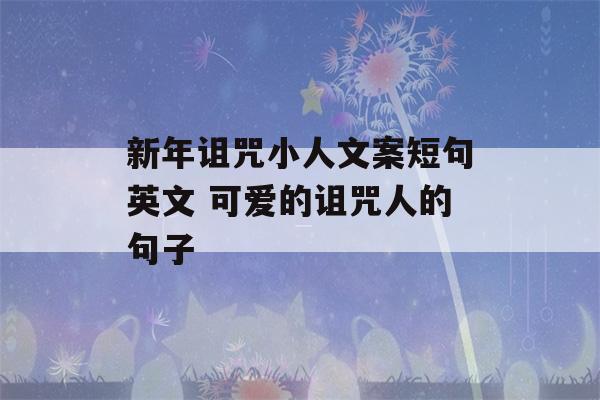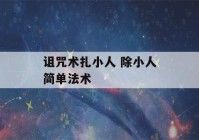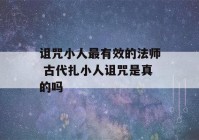新年诅咒小人文案短句英文 可爱的诅咒人的句子
大家好,今天莱特星座网给大家分享「新年诅咒小人文案短句英文 可爱的诅咒人的句子」的知识,如果能碰巧解决你现在面临的问题,记得收藏本站或分享给你的好友们哟~,现在开始吧!
Introduction
New Year's curses are a timeless cultural phenomenon that persists in various forms across different societies. In this article, we will explore the concept of New Year's curses and how they are often associated with the idea of "little people." These curses, while being part of folklore and superstition, have a way of lingering in the subconscious minds of people, shaping their attitudes and behaviors. We will delve into six aspects to provide a comprehensive understanding of this intriguing subject.
1. Historical Origins of New Year's Curses
The origins of New Year's curses can be traced back to ancient civilizations, where people believed in supernatural beings with the ability to bring misfortune upon others. In Chinese folklore, for example, the "little people" are known as "小人" (xiǎo rén) and are often blamed for causing mischief and troubles during the New Year. It is believed that these curses originated as a way to explain the unexplained, and to provide a sense of control in an unpredictable world.
Historical records show that the practice of cursing little people during the New Year has been around for centuries, with variations found in different cultures. These curses were traditionally carried out through rituals or written incantations, designed to ward off the malevolent influence of the little people and ensure a prosperous year ahead. Over time, these curses became ingrained in the collective consciousness, passed down through generations.
2. Beliefs and Superstitions Surrounding New Year's Curses
New Year's curses are deeply rooted in beliefs and superstitions that have been passed down for generations. Many people believe that curses from the little people can bring misfortune, such as financial loss, health problems, or relationship troubles. As a result, there are various rituals and practices aimed at protecting oneself from these curses.
One common belief is the need to clean the house thoroughly before the New Year to remove any lingering negative energy. This is done to ensure that the little people have no reason to stay and cause trouble. Similarly, it is believed that wearing red clothing can fend off curses, as red is considered a lucky color in many cultures.
Superstitions surrounding New Year's curses fuel the sale of various amulets, charms, and tali *** ans, all aimed at protecting individuals from the malevolent intentions of the little people. These beliefs may seem irrational to some, but they play an important role in shaping people's behaviors and attitudes during the New Year.
3. Cultural Significance and Impact
While New Year's curses and the belief in little people may be di *** issed as mere superstition by some, it is important to recognize their cultural significance. Curses, folklore, and traditions are integral to a society's cultural fabric, serving as a means to connect individuals with their heritage and provide a sense of identity.
Additionally, the belief in New Year's curses and little people can have a profound impact on individuals' mental states. The fear of being cursed or the belief that misfortune is inevitable can create anxiety and stress, affecting one's overall well-being. These beliefs, regardless of their veracity, can shape people's behaviors and decisions, leading to self-fulfilling prophecies.
Understanding the cultural significance and impact of New Year's curses allows us to appreciate the complexity of human beliefs and traditions, even if they may seem irrational or superstitious to outsiders.
4. Psychological Explanations for Belief in New Year's Curses
Psychologists have offered several explanations for the enduring belief in New Year's curses. One such explanation is the concept of attribution bias, where individuals tend to attribute negative outcomes to external sources rather than taking personal responsibility. The belief in little people's curses provides an external scapegoat for any misfortune during the New Year, protecting individuals from feelings of guilt or shame.

Furthermore, the fear of the unknown and the need for control are deeply ingrained in human psychology. New Year's curses offer an explanation for the inexplicable and provide a sense of control over unpredictable events. By attributing misfortune to the little people, individuals can regain a sense of agency and control over their lives.
Psychological explanations help shed light on the underlying motivations and cognitive biases that drive the belief in New Year's curses, highlighting the complex interplay between culture, psychology, and belief systems.
5. Modern Interpretations and Adaptations
In today's rapidly changing world, the concept of New Year's curses and little people has evolved and adapted to fit modern contexts. While traditional rituals and practices still persist, there are also new interpretations and adaptations of these beliefs.
One example is the portrayal of little people in popular culture, such as movies and literature. They are often depicted as mischievous but ultimately harmless creatures, adding a sense of whimsy and fantasy to the concept of New Year's curses.
Furthermore, some individuals have embraced the idea of using New Year's curses as a metaphorical way to let go of negative experiences from the past year. By "cursing" their own negative thoughts and emotions, they hope to start the New Year on a clean slate, free from the burdens of the past.
These modern interpretations and adaptations reflect the ever-evolving nature of folklore and beliefs, as societies continue to evolve and adapt to changing times.
6. Critici *** s and Skeptici ***
As with any belief or superstition, the concept of New Year's curses and little people has its fair share of critics and skeptics. Skeptics argue that these beliefs are nothing more than baseless superstition and should be discarded in favor of rational thinking and scientific explanations.
Critics also point out the potential harmful effects of these beliefs, such as causing unnecessary fear and anxiety or perpetuating harmful stereotypes. They argue that fostering a culture of rationality and critical thinking is essential for societal progress and individual well-being.
While skeptici *** is necessary and healthy, it is also important to respect the cultural significance and personal beliefs of others. The discussion and exploration of New Year's curses should be approached with an open mind and a willingness to understand different perspectives.
Conclusion
New Year's curses and the belief in little people offer a fascinating glimpse into the realm of folklore, superstition, and cultural traditions. While they may seem irrational or superstitious to some, these beliefs shape the way individuals think, act, and perceive the world around them. By delving into the historical origins, psychological motivations, and cultural significance of New Year's curses, we gain a deeper understanding of the complexities of human belief systems and the ways in which they shape our lives.
以上就是关于「新年诅咒小人文案短句英文 可爱的诅咒人的句子」的全部内容,本文讲解到这里啦,希望对大家有所帮助。如果你还想了解更多这方面的信息,记得收藏关注本站~
-
上一篇
辟邪斩小人的神仙是谁 管小人的神仙 -
下一篇
泰国情降丸 泰国情降膏吃了有没有影响







